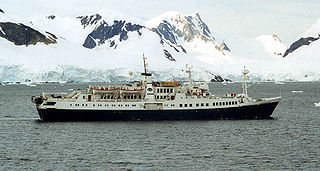Related Research Articles

Joinville Island is the largest island of the Joinville Island group, about 40 nautical miles long in an east–west direction and 12 nautical miles wide, lying off the northeastern tip of the Antarctic Peninsula, from which it is separated by the Antarctic Sound.

Toney Mountain is an elongated snow-covered shield volcano, 38 nautical miles long and rising to 3,595 metres (11,795 ft) at Richmond Peak, located 35 nautical miles southwest of Kohler Range in Marie Byrd Land, Antarctica.

The Executive Committee Range is a range consisting of five major volcanoes, which trends north-south for 50 nautical miles along the 126th meridian west, in Marie Byrd Land, Antarctica.

Joinville Island group is a group of antarctic islands, lying off the northeastern tip of the Antarctic Peninsula, from which Joinville Island group is separated by the Antarctic Sound.
Cape Darnley is a cape at the southeast side of Jacobsen Bight on the south-central coast of South Georgia. The name dates back to about 1920 and was given for E.R. Darnley of the Colonial Office, Chairman of the Discovery Committee from 1923 to 1933.
Atherton Peak is a peak rising to about 500 metres (1,600 ft) east of Fortuna Bay, South Georgia. It was charted by Discovery Investigations, 1929–30, and named after Noel Atherton, cartographer in the Admiralty Hydrographic Office at the time, later chief Civil Hydrographic Officer, 1951–62.
Fortuna Bay is a bay 3 miles (5 km) long and 1 mile (1.6 km) wide. Its entrance is defined by Cape Best on the west and Robertson Point to the east, near Atherton Peak on the north coast of South Georgia. It was named after the Fortuna, one of the ships of the Norwegian–Argentine whaling expedition under C.A. Larsen which participated in establishing the first permanent whaling station at Grytviken, South Georgia, in 1904–05. The Second German Antarctic Expedition (SGAE) under Wilhelm Filchner explored Fortuna Bay in 1911–12. Discovery Investigations (DI) personnel charted the area during their 1929–30 expedition.
Philippi Glacier is a glacier flowing east into Brandt Cove on the southwest side of Drygalski Fjord, at the southeast end of South Georgia. Charted by the German Antarctic Expedition, 1911–12, under Wilhelm Filchner, who named it for Emil Philippi, glaciologist with the German Antarctic Expedition, 1901–03, under Erich von Drygalski, and professor of geology at the University of Jena.
Mount Back is a peak, 650 metres (2,130 ft) high, located 1.5 nautical miles (3 km) south of Doris Bay, South Georgia. It was named by the UK Antarctic Place-Names Committee for Squadron Leader Anthony H. Back, Royal Air Force, assistant surveyor with the British Combined Services Expedition of 1964–65, who assisted in the survey of this peak.

Bildad Peak is a conspicuous snow-capped peak 5 nautical miles (9 km) west of Spouter Peak on the south side of Flask Glacier in eastern Voden Heights, on Oscar II Coast in Graham Land. It was surveyed by the Falkland Islands Dependencies Survey in 1955, and named by the UK Antarctic Place-Names Committee after the fictional Captain Bildad, part-owner of the whaling ship Pequod in Herman Melville's Moby-Dick.
Neuburg Peak is a jagged rock peak in Antarctica, 1,840 metres (6,040 ft) high, rising 2.5 nautical miles east of Walker Peak in the southwest part of Dufek Massif, Pensacola Mountains.
Welch Mountains is a group of mountains that dominate the area, the highest peak rising to 3,015 metres (9,892 ft), located 25 nautical miles north of Mount Jackson on the east margin of the Dyer Plateau of Palmer Land, Antarctica
Coronda Peak is a peak over 610 metres (2,000 ft) high, standing north of Leith Harbour on the north coast of South Georgia. The name appears on a chart showing the results of surveys by Discovery Investigations personnel in 1927 and 1929, and is probably after the SS Coronda whose captain was of assistance to the survey party.
Kosco Glacier is a glacier about 20 nautical miles long, flowing from the Anderson Heights vicinity of the Bush Mountains of Antarctica northward to enter the Ross Ice Shelf between Wilson Portal and Mount Speed.
Treble Peak is a peak with three summits rising to about 610 m, situated east of Fortuna Bay and 0.5 nautical miles (0.9 km) south of Mount Harper on the north coast of South Georgia. Charted and named descriptively by DI personnel in 1929.

Paradise Harbour is a wide embayment behind Lemaire Island and Bryde Island, indenting the west coast of Graham Land, Antarctica, between Duthiers Point and Leniz Point. The name was first applied by whalers operating in the vicinity and was in use by 1920.
Fortuna Peak is a peak, 385 metres (1,260 ft) high, standing at the east side of Fortuna Bay, on the north coast of South Georgia. The name appears to be first used on a 1931 British Admiralty chart, and is probably in association with Fortuna Bay.
Harper Peak is a peak, 785 metres (2,575 ft) high, standing east of Fortuna Peak and Fortuna Bay on the north coast of South Georgia. The name appears to be first used on a 1931 British Admiralty chart.

Sohm Glacier is a glacier flowing into Bilgeri Glacier on Velingrad Peninsula, the west coast of Graham Land. Charted by the British Graham Land Expedition (BGLE) under Rymill, 1934–37. Named by the United Kingdom Antarctic Place-Names Committee (UK-APC) in 1959 for Victor Sohm, Austrian skiing exponent who invented a special type of ski skins and ski wax.
References
 This article incorporates public domain material from "Best Peak". Geographic Names Information System . United States Geological Survey.
This article incorporates public domain material from "Best Peak". Geographic Names Information System . United States Geological Survey.